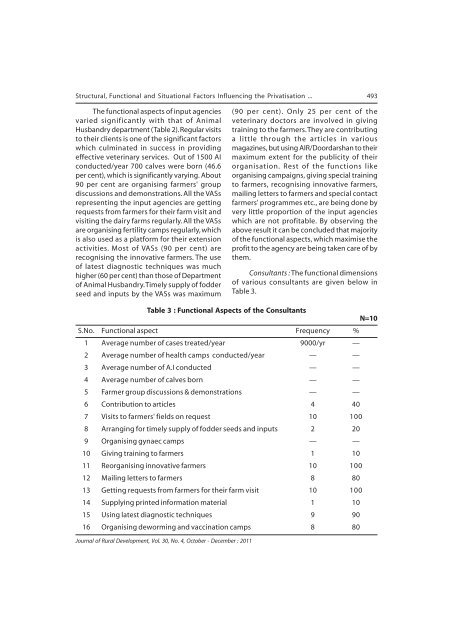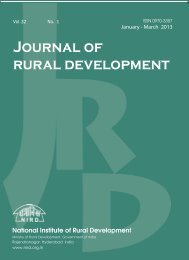Issue for October - December 2011 - National Institute of Rural ...
Issue for October - December 2011 - National Institute of Rural ...
Issue for October - December 2011 - National Institute of Rural ...
You also want an ePaper? Increase the reach of your titles
YUMPU automatically turns print PDFs into web optimized ePapers that Google loves.
Structural, Functional and Situational Factors Influencing the Privatisation ... 493The functional aspects <strong>of</strong> input agenciesvaried significantly with that <strong>of</strong> AnimalHusbandry department (Table 2). Regular visitsto their clients is one <strong>of</strong> the significant factorswhich culminated in success in providingeffective veterinary services. Out <strong>of</strong> 1500 AIconducted/year 700 calves were born (46.6per cent), which is significantly varying. About90 per cent are organising farmers' groupdiscussions and demonstrations. All the VASsrepresenting the input agencies are gettingrequests from farmers <strong>for</strong> their farm visit andvisiting the dairy farms regularly. All the VASsare organising fertility camps regularly, whichis also used as a plat<strong>for</strong>m <strong>for</strong> their extensionactivities. Most <strong>of</strong> VASs (90 per cent) arerecognising the innovative farmers. The use<strong>of</strong> latest diagnostic techniques was muchhigher (60 per cent) than those <strong>of</strong> Department<strong>of</strong> Animal Husbandry. Timely supply <strong>of</strong> fodderseed and inputs by the VASs was maximum(90 per cent). Only 25 per cent <strong>of</strong> theveterinary doctors are involved in givingtraining to the farmers. They are contributinga little through the articles in variousmagazines, but using AIR/Doordarshan to theirmaximum extent <strong>for</strong> the publicity <strong>of</strong> theirorganisation. Rest <strong>of</strong> the functions likeorganising campaigns, giving special trainingto farmers, recognising innovative farmers,mailing letters to farmers and special contactfarmers' programmes etc., are being done byvery little proportion <strong>of</strong> the input agencieswhich are not pr<strong>of</strong>itable. By observing theabove result it can be concluded that majority<strong>of</strong> the functional aspects, which maximise thepr<strong>of</strong>it to the agency are being taken care <strong>of</strong> bythem.Consultants : The functional dimensions<strong>of</strong> various consultants are given below inTable 3.Table 3 : Functional Aspects <strong>of</strong> the ConsultantsN=10S.No. Functional aspect Frequency %1 Average number <strong>of</strong> cases treated/year 9000/yr —2 Average number <strong>of</strong> health camps conducted/year — —3 Average number <strong>of</strong> A.I conducted — —4 Average number <strong>of</strong> calves born — —5 Farmer group discussions & demonstrations — —6 Contribution to articles 4 407 Visits to farmers' fields on request 10 1008 Arranging <strong>for</strong> timely supply <strong>of</strong> fodder seeds and inputs 2 209 Organising gynaec camps — —10 Giving training to farmers 1 1011 Reorganising innovative farmers 10 10012 Mailing letters to farmers 8 8013 Getting requests from farmers <strong>for</strong> their farm visit 10 10014 Supplying printed in<strong>for</strong>mation material 1 1015 Using latest diagnostic techniques 9 9016 Organising deworming and vaccination camps 8 80Journal <strong>of</strong> <strong>Rural</strong> Development, Vol. 30, No. 4, <strong>October</strong> - <strong>December</strong> : <strong>2011</strong>
















